If you want an e-commerce business to succeed you need happy customers that keep coming back!
Happy customers turn into loyal customers.
Loyal customers are ones that love your brand, your product, and are likely to spread the word about you to friends, family, and (most importantly) all over their social media!
But there is a way to encourage those same happy, loyal customers to talk about you even more! If you set up an e-commerce referral program, they can earn money by recommending your products to others. That’s a win-win situation!
As humans, we naturally trust the word of people we like and admire. We have natural drives to share positive experiences (or products). By incentivizing that instinct, you are encouraging them to put their thoughts into action.
An e-commerce referral marketing program can help you monetize word-of-mouth. Use the fact that people like your products and are talking about your brand to your benefit!
When done right, it can put your marketing on autopilot and bring in traffic that is ready to buy.
In this article, we’ll take a look at:
- Putting sales on autopilot with an e-commerce referral program
- The best incentives for your program
- Growing and scaling your referral program
Let’s start with a look at why referral programs are effective.
Word-of-mouth marketing & e-commerce referral marketing programs
A recent survey found that Americans value word-of-mouth recommendations from friends and family 41% more than social media recommendations. That’s not an attack on social media referrals (which we’ll dive into later), but it does make it clear that word-of-mouth marketing is effective.
Most of us communicate and pass on word-of-mouth recommendations through the internet.
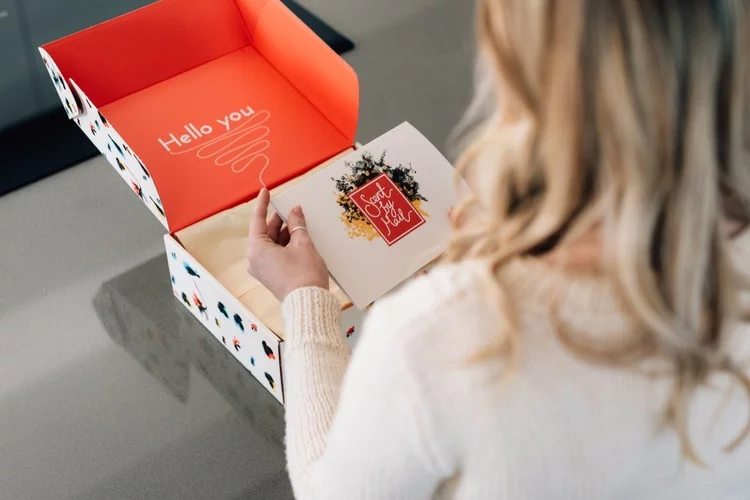
This is great for you as an e-commerce business owner! The internet is the ideal environment for a customer’s referral code to be easily shared via text message or some other means of communication. This is where modern word-of-mouth marketing happens.
There are two main reasons why word-of-mouth marketing is so effective on all of us.
- We trust word-of-mouth marketing
- We interact with people we trust online more than we do in real life.
When you combine trust in your online store with regular online interactions, you create the perfect environment for loyal customers to bring in more sales from their immediate friends and family.
Getting started
Before you race out and start your referral program, you will need to lay a few foundations first.
1. Leveraging loyal and satisfied customers
Imagine that you’re in a new coffee shop for the first time. You pay, and as the barista hands you your coffee, they ask you to tell your friends about their shop.
You haven’t even tried the product, yet you’re being told to tell your friends about it.
How would you feel about the coffee shop if you encouraged others to try it only to find out the coffee is terrible?
Now, imagine that you’re a regular in the coffee shop and that you genuinely love their coffee, the people, and everything about the company.
Your regular visits are what tell the barista you like their coffee - and that more than likely you’d be happy to share the store’s name with friends.
The same theory applies to your e-commerce store.
Regular customers are the perfect customers to target when you launch an e-commerce referral program. They’ve spent a lot with you. They know your product and brand. They’re the ideal people to spread your brand’s name in social circles.
Your referral program is more likely to succeed when you target loyal recurring customers. But it is worth noting that you may find first-time buyers are also interested in taking advantage of your program.
There’s no magic number of sales a customer should have before you offer them your referral program.
However, it’s more important to build and foster customer loyalty among first-time buyers than tell them to talk to their friends about you - just like the coffee shop example.

It is almost impossible to build a successful referral program if your business is in its infancy. You need a base of clientele that knows you and your products. If you are just starting out you won’t have that trust just yet. Give it a little time and put your effort into getting those first sales before you decide to dive into the world of referrals.
You can start getting your first initial sales by using Facebook ads or finding other ways to bring in engaged traffic from your niche.
2. Business model & brand image
B2B, B2C, D2C, PoD, and dropshipping. The world of e-commerce has many different business models, and each one needs a unique, fine-tuned approach to grow referrals.
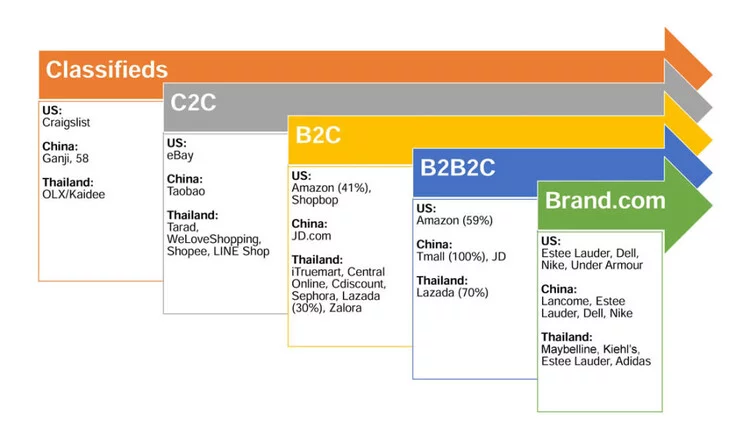
Incentivized e-commerce referral programs take a portion of your profits, and some business models are more profitable than others.
Here are a few angles to consider about various business models when considering using a referral program:
- Dropshippers who struggle with the quality of products they don’t see before making a sale may struggle to build customer loyalty.
- D2C brands that retain high-profit margins may find it easier to justify trading overall profits for increased brand awareness.
- Marketplace resellers that pay large sums in fees and have small profit margins may not want to share that margin with customers.
For example, let’s look at a Print-on-Demand t-shirt business. Many PoD communities have stated that profit margins are quite low. Redirecting already low profits into an incentivize e-commerce referral program may stun your business’s development.
On the other hand, a company that’s pocketing good profits from a high-quality, handmade product may be willing to share profits with loyal customers who refer new customers.
But if you’re an e-commerce business that offers customized products, a referral program may also present a few roadblocks.
Customization means exclusivity. Something made for ‘me’ means no one else has it, so the product has more inherent value. Telling my friends to get their own customized product like mine undermines the perceived exclusivity that I have in my custom product.
This theory also applies to luxury goods - there’s a reason Chevrolet dealers offer a referral program, but Ferrari doesn’t.
3. Value is everything
A referral program’s core foundation is asking people to recommend your product to people they know and love.
If your product isn’t worthy of kind words, your referral program won’t be effective.
It is also essential that you have a product that overshadows your competitors. While a quality product is important, brand value is what leaves a customer feeling like they got more than what they paid for. Brand value helps set your brand and your product apart from competitors.

Here is a list of ways you can invest in and improve your brand value.
- Deliver your product to customers in custom packaging
- Establish a rock-solid return and refund policy
- Have multiple support channels
- Create an unboxing experience that leaves a lasting first impression
While the items on that list are not directly related to the physical product you’re selling, they have everything to do with building trust and loyalty, and increasing customer satisfaction.
4. You need a budget
Getting your program in front of customers costs money - marketing funnels, automating emails to remind customers, Facebook ads, or content creation to support the program - it all costs money.
Then there are the costs associated with the program itself. Are you giving people $10 credit for every sale they bring in?
You’ll need to have the capital to invest in getting your referral program up and running. Once up and running, it should then start receiving cash flow from your profits.
You’ve gotta spend money to make money.
5. You need to be loved
A solid brand reputation is paramount to an effective referral program.
Lousy product reviews, unmoderated social media comments, and any bad blood associated with your brand are going to hinder the launch, growth, and development of your referral program.

Asking people to spread your brand’s name while your brand’s reputation is tarnished can cause all the effort and resources you put into building a referral program to be wasted.
6. Know your customers
You can never know too much about the people that give you their money.
- Why do they love your product?
- What features do they use to ‘sell’ your product to their friends and family?
- How much do they usually spend the first time around?
- What incentives are essential to them?
Customer surveys are a great way to find out all this information and more. Consider sending a survey to anyone that signs up to your referral program and asking them a few quick questions.
What’s the most popular product referred customers buy? Adjust your pricing to compensate for any discount incentives.
Are referred customers only making one purchase and never returning? Revise your incentives for first-time referred buyers.
What are the acquisition channels of your best referrers? Double down on this channel to find more high-volume referrers.
Your findings can help you grow and scale your referral program, and ultimately, your brand’s notoriety.
E-commerce Referral Marketing Program Models
Ok, so now you know it’ll work for you, and you want to put your plan into action.
Let’s check out the best e-commerce referral program models so you can find the right one for your business, product, and customers.
The most important thing to keep in mind is:
Think about how you can encourage your existing customers to be willing to refer your brand to others.
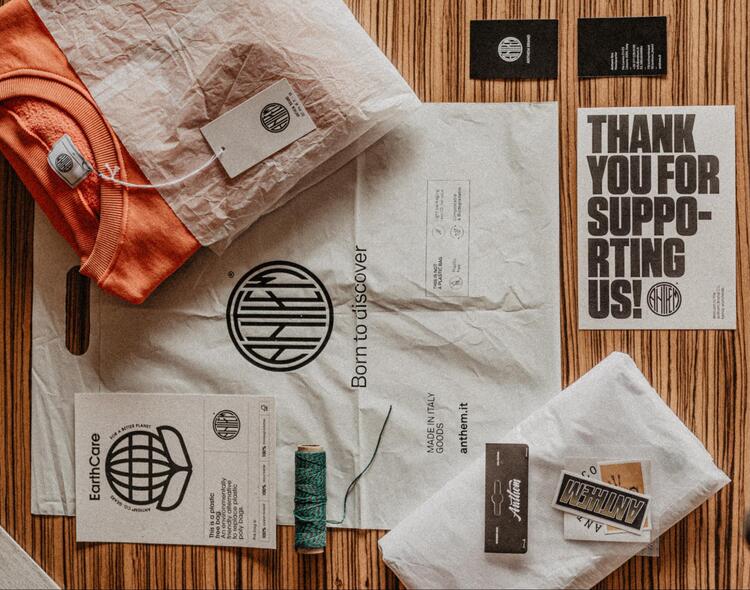
That is, after all, the premise of a referral campaign.
Remember, the point of this campaign is to provide enough value to your existing customers to get them to refer you to others.
1. Store Credit
Giving someone ‘credit’ to use in your store is the most common form of referral bonus.
Below you can see how ibotta offers $50 to any existing customers who refer five friends.
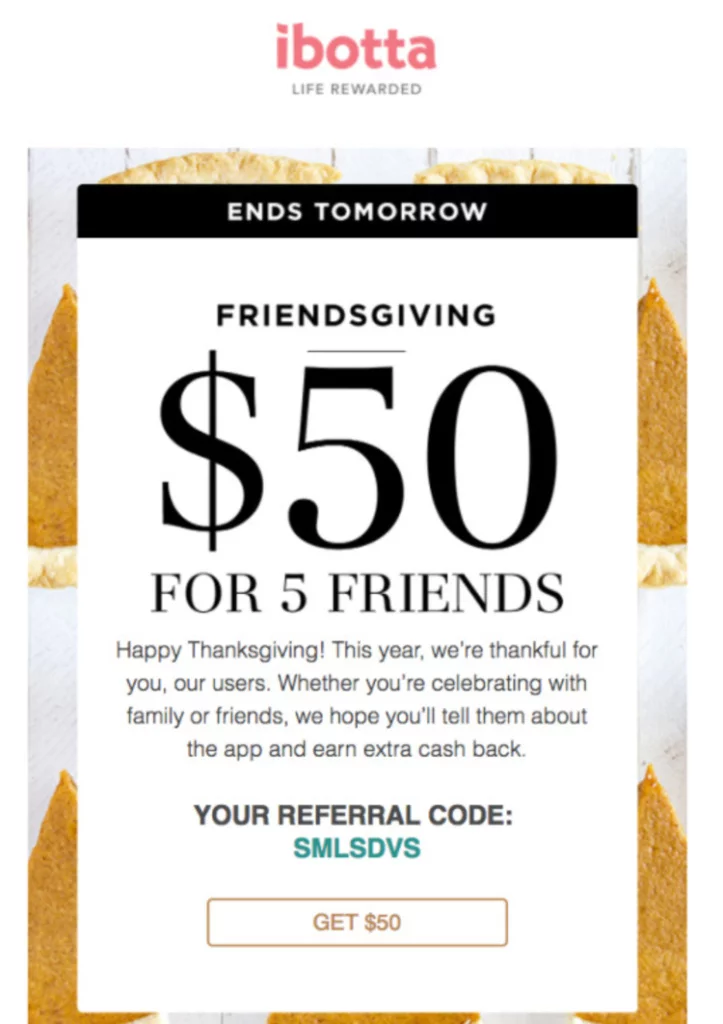
Ibotta knows the average spend of users within their ‘cashback’ app, and they know that $50 is no small amount. Therefore, if an existing customer can get five friends to sign up and use their app, the referrer will be gifted a $50 credit.
This concept works the other way, too.
Below you can see how meundies offers an incentive for both the referrer and the person being referred.

The person who does the referring gets a $20 credit, while the new customer gets 20% off their first purchase.
This strategy is a mighty, double-edged sword.
The 20% off a first order makes it easier for new customers to convert, and it’s also a ‘sales point’ for your referrer.
This method requires a little extra tracking to ensure that both bonuses are used in a reasonable amount of time and that your generosity isn’t exploited.
Tips for structuring your store credit
Offering credit gives customers the feeling of ‘cash in the bank.’
Your bank.
That money is there for them to spend, but it can only be spent in your store. Whether it’s a fixed amount or a percentage of the overall spend is dependent on your business economics.
Below you can see how allset gives customers $5 for every referral.
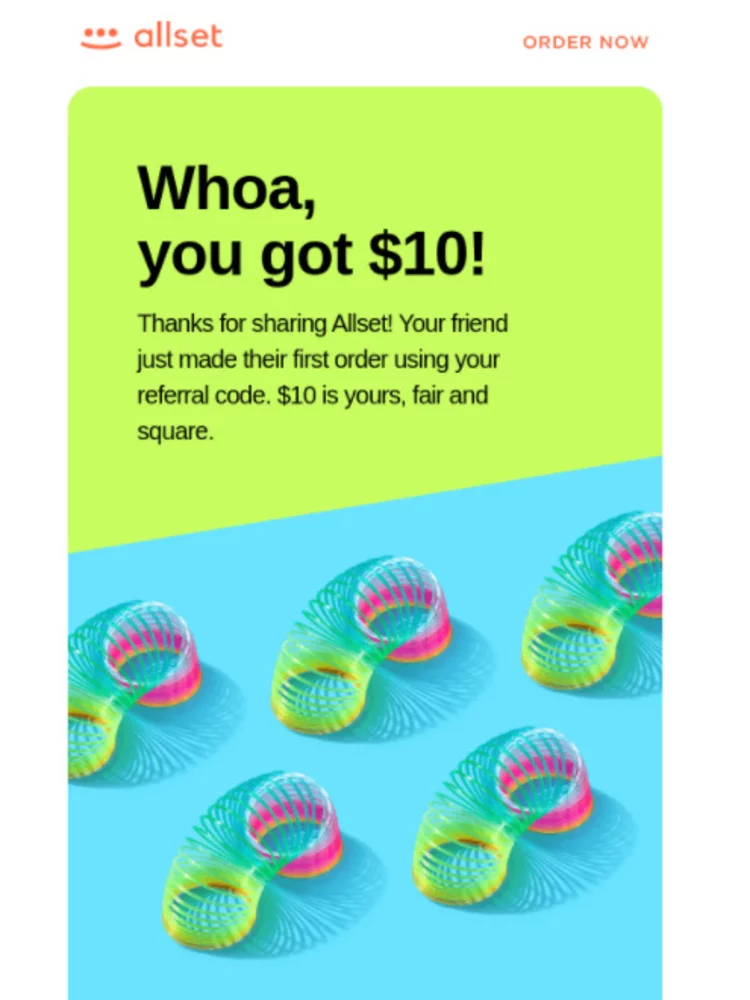
These cash bonuses can accumulate quite quickly in your customer’s account and be a massive driver in making them buy from you again.
2. Referral options for loyal repeat buyers:
If you’re lucky enough to have a few customers that keep coming back time and time again, they’re the best customers to incentivize.
But rather than offering the referral program to first-time buyers, you can give them access to it only after they’ve made a second purchase. Use your referral program as ‘bait’ to get a second purchase. This encourages the second purchase and gives anyone else referred to do their own referring after their second purchase.
The cycle grows, your customers’ lifetime value increases, and you exponentially expand your customer base.
This process also keeps new customers loyal to your brand (and encourages them to avoid looking at competitors); customers get a good product as well as discounts to tell their friends about it.
Add a bonus for the referrer and the referee (as you read earlier), and you’ll add some extra incentive!
3. Bonus Perks
If you’re reluctant to give away financial incentives, other perks can sweeten the deal for referrers.
Point programs are a great way to implement bonuses - for example, for the 10th referral, your customer gets a free product. It’s a series of small, visualized, incremental steps toward a goal, at which point, there’s a reward.
Other perks can be:
- Early access to new products
- Extended warranties
- Free shipping for the next 12 months
There are many other things that you can offer - you may need to get creative, though. Ultimately, you’ll need to measure, test, and assess what works for both your business and your customers.
Promoting Your Referral Marketing Program
Once you’ve set up your program, it’s time to promote it and get people to start using it.
1. Invite Your Most Loyal Customers
Your past customers are the optimal base for starting a referral program. Launch an email campaign to get those who recently made a purchase to use their personal referral code.
To minimize the work they have to do, send their code in the announcement email. This makes it easier for them which, in turn, makes them more likely to follow through with the desired action.
2. Provide the information post-checkout
Place a custom referral code on your order confirmation page. This is a great time to get your customers’ attention, as their trust is at its highest, they’re engaged, and thinking about your brand.
Automate emails to be sent a few weeks or even months after your customer’s initial purchase to remind them about the referral code if they haven’t already used it.
Also, include it in shipping emails as another reminder of a way they can earn some in-store credit.
3. Build a Landing Page on Your Website
Referral programs don’t have to be exclusive to existing customers. In fact, it can be an effective way to encourage potential customers who have never purchased from you, but like your brand or product.
Create a landing page that advertises the referral program on your website.
Here, you can see how the women’s leggings brand Gearbunch has built a landing page for their referral program.
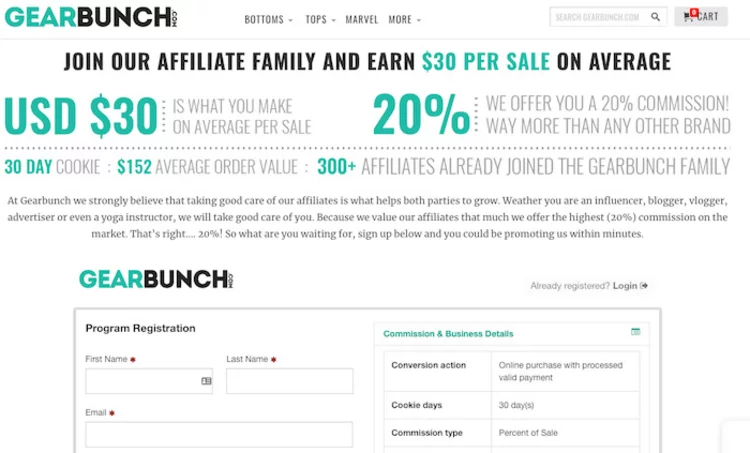
Get the relevant information into a landing page, and then build internal links to it from other sections of your website by placing the links in:
- A call-to-action button in the header or footer
- On product pages
- In the FAQs section
- In pop-ups
- Promote your referral program on Social Media
Social media marketing is also another way to get your referral program in front of loyal followers.
Whether it’s a simple post or part of a paid social media campaign, Facebook, Twitter, and Instagram can be great channels to get your new program seen and used.
While it’s not an e-commerce referral program, you can see below how the medical research facility Celerion uses social media to promote its refer a friend campaign.
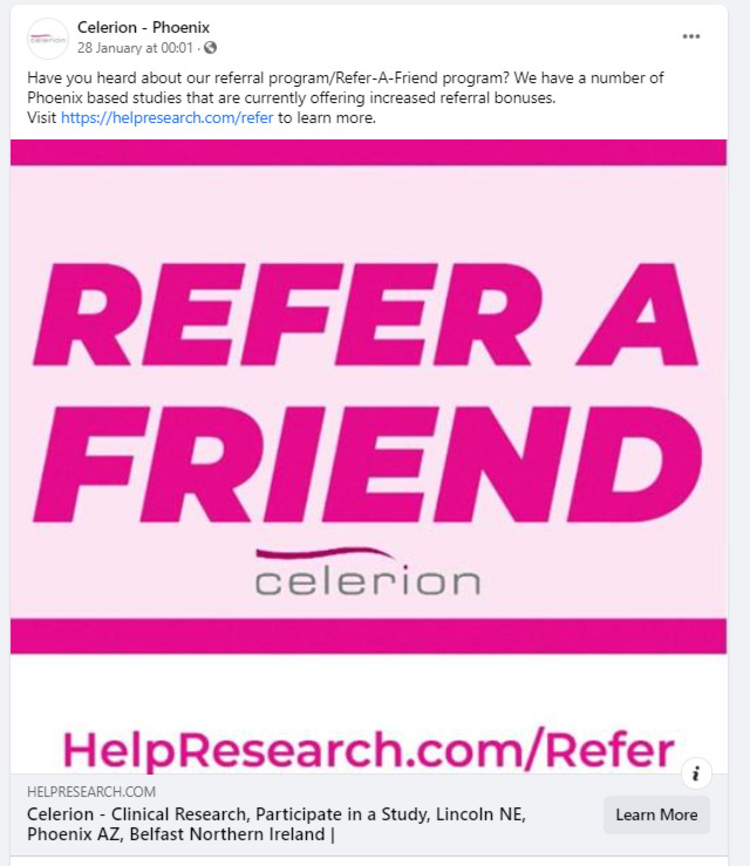
Final Thoughts on Referral Marketing for E-commerce
An e-commerce referral program isn’t a quick way to get sales. It’s part of a long-term marketing strategy that can really make a difference to your business.
But they work!
There’s a lot of planning, testing, and assessing involved in making a referral program that works for your brand. With the right product and loyal customers, you’ll build loyalty, sales, and ultimately revenue.




